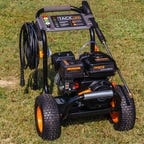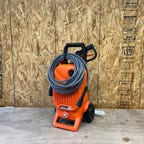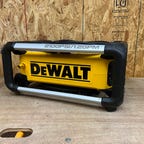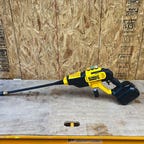Best Pressure Washer for 2024
Residential pressure washers can keep the outside of your home spotless. Here are the best pressure washers to get for outdoor cleaning, tested by us.
Our Picks
Home maintenance isn't easy. In addition to all the daily tasks, you need to take care of the lawn, clean the windows regularly, and remember to clean out your dryer vents. One way to cut some of the stress related to home cleaning is to get the best pressure washer. Pressure washing can get the job done quickly, leaving your home clean.
I tested electric and gas-powered pressure washers to find the top models in various categories. There are a few differences between gas washers and their electric-powered relatives. Electric pressure washers typically max out at around 2,000 psi. A gas engine may dip below that figure, but all the gas models I've tested go from 2,000 psi and move on up.
Different body styles exist when it comes to electric pressure washers. Some models copy typical gas-powered washers. Some suitcase-style models tend to run at a slightly lighter-duty level. Operating at an even lighter-duty level are the cordless models, which are battery-powered. You can't quite compare each of these styles directly to each other, just like you can't directly compare an electric model to a gas pressure washer, unless the performance specs match.
Other pressure washers, on the other end of the spectrum, are commercial washers that typically start at around 3,500 psi. These are unlike most pressure washers you'd find in a home, and they're designed for professional use with a higher flow rate and water pressure. Our list doesn't include these models and instead focuses on pressure washer models that cost $600 or less. While picking the best power washers for this list, I considered factors such as the washer's maximum pressure, the inclusion of different nozzle tips, and even hose length. I update this best pressure washer list periodically.
Best pressure washers
All things considered, this guy ticked enough of the right boxes to come out on top as the best pressure washer. The assembly is easy enough out of the box, and the power washer itself is heavier (no plastic frame pieces) and sits low to the ground, giving it a solid feel. Of all the units I tested, this one felt the most balanced to me as I moved it around. Enough of the others felt unbalanced or wobbly for this to be a determining factor.
It's priced just below the overall average price of all units I tested, and that says something since its water pressure output and engine size are among the top specs overall. The spray wand is nothing special, but tool storage is fine, and it ships with all five standard spray gun tips (not all of them do). There is also an attached detergent tank, which I think is great, even though I don't often use detergent with my gas washer.
This specific model is no longer available at Tacklife, but one with what may be the same build (and same specs) is available through The Home Depot as a Simpson PowerShot-branded model.
Best value gas-powered pressure washer
Westinghouse WPX3200
This Westinghouse model is cheap, and it has great specs and performance, but it's also so devoid of overwhelmingly positive or negative features that it's easy to overlook.
Here are the highlights: lowest price tag, largest engine, detergent tank and all five interchangeable nozzles included. Everything else about this residential pressure washer cleaning unit is entirely middle-of-the-road.
Best value electric pressure washer
Black & Decker BEPW1850
$149 is a fairly low buy-in for the pressure washer game. If you're looking for a nongas unit on the cheap, this might be what you're looking for. As far as numbers go, this one has a 1,850 psi rating, which is the lowest of the standard body type electric pressure washers, but when you're using it, it feels like it gives as much as any of the other units.
This unit doesn't have any outstanding features, but it does have a fair amount of power packed into a small package. It sports a suitcase-style retracting handle and is overall compact enough to be stowed away on a shelf somewhere. Although you can clean some tough grime from concrete, this wouldn't be my first pick for that task unless it was a very small area. Otherwise, this Black & Decker model can handle most other common pressure washer jobs.
Best portable pressure washer
DeWalt DWPW2100
If you have the need to move from location to location with your pressure washer often, and you don't necessarily need the higher cleaning power of a gas unit, the DeWalt DWPW2100 is a great option. This thing folds up like a suitcase, retractable handle and all, stores all accessories and cords/cables onboard and you're off, wheeling your way to your next destination.
Its performance is on par with other similar-spec units, but I feel like the biggest win here is portability. I do also like that the storage for the different nozzles is attached to the wand itself.
The price tag is higher than many others, but if you need this kind of mobility with your pressure washer, chances are the few extra bucks are worth it.
Best handheld pressure washer
DeWalt DCPW550P1
I do enjoy the idea of adding a pressure washer option to cordless tool ecosystems. You already have the batteries and tool storage options, and having a readily available pressure washer (just add a hose from a tap or to a bucket you've gathered water in) is great for quick cleanup jobs.
The main drawback with this form of pressure washer would be its overall power. Containing everything in the palm of your hand does have its trade-offs, so don't expect to de-grime your concrete patio or driveway with these tools. They are great for worksites where you accumulate lots of associated debris, or maybe light yard waste. Again, the fact that you can carry a water container with you to a remote area where water is otherwise unavailable will undoubtedly appeal to some people.
Don't worry about your batteries. These cordless tool versions have a built-in housing to protect that sensitive electronics area from direct water exposure.
Other units we've tested
Here is a list of the other washers I've tested to date, in no particular order:
- Craftsman CMXGWAS020733: This is a good basic cleaning unit at a low price. I especially like its power cord pull location compared to most washers. Still, the lighter-duty feel of the upright form factor, plastic housings, and missing yellow tip mark this one down.
- Generac 8874: Lowest cost of the gas-powered group with a good wand option. No onboard detergent tank, missing yellow tip, plastic housings, loose spray wand storage and unbalanced wheel alignment prove that you get what you pay for.
- Ryobi 803001: Priced in the middle of the group with a good attempt at a multi-nozzle tip option, the Ryobi sports the smallest engine specs and otherwise has OK cleaning power, enough to get the job done.
- Simpson MSH3125: One of the higher-priced units, with solid metal parts and a low center of gravity. Otherwise, no onboard detergent tank, loose spray wand storage, and (at least on my unit) more than normal engine vibration.
- Teande 4200PSI: Looks great on paper and does actually include all five basic nozzle tip types and a neat double reservoir. You have to survive the tedious assembly and still be OK with loose spray nozzle wand storage as a tradeoff. The specified high pressure of 4,200 psi offers no real-world advantage over the other washers rated at about 1,000 less psi.
- Greenworks Pro 2300: I tested both the 2,300 and 3,000 psi versions of the Greenworks Pro electric pressure washer series. The 2300 performs well; about what you'd expect. Very few of the electric pressure washers come with the zero-degree red tip, so if you're not looking for that concentrated flow out of the box, but still want a mid-tier option, the 2300 is a decent choice.
- Greenworks Pro 3000: Jumping up to the 3000 from the 2300 Pro series from Greenworks, you can feel the difference and increase in performance between the units. I'm also a fan of the lower and wider body style used here like we've seen with Tacklife and DeWalt. There is a bit of a price jump, but if you're going electric and your pressure washer load is on the heavier side, it would be worth the cost increase.
- Rock&Rocker 3500: This is the lowest-priced option of the units we've tested. Although it touts a maximum psi of 3,500, it doesn't feel like it operates anywhere near that number (it does list its nominal psi as 1,850). If you can overlook that, it's not bad for $130. It does have a couple of features I'd like to see more of -- namely the built-in hose reel as well as added support for the spray wand.
- Chemical Guys ProFlow PM2000: I do like these suitcase-style bodies -- they're more actively mobile than the traditional body style, and lighter (also a big fan of the rotating casters). Even though this unit isn't particularly powerful, my main gripe here is with accessory storage. This is the only unit that doesn't seem to have any type of accessory storage built in, for the power cable, spray wand or hose attachment. It does have a spot for the small interchangeable spray tips, but not for everything else.
- DeWalt DWPW2400: This pressure washer, like most DeWalt products, feels solid enough, but I will say that its spray performance did feel a bit underpowered for its stated specs. I have no real issues with its performance otherwise. A solid buy, but one I feel deserves a slightly lower price.
- Craftsman CMEPW2100: Another solid buy at $220 and probably my second-place pick for value buy in electric pressure washers. Good hardware, good performance. Also maybe one of my new favorite features for accessory storage. The spray wands always seem to be loosely stored, rocking about, or falling off. The CMEPW2100 utilizes a tab and slot design to hold the wand securely. I love it.
- Craftsman CMCPW350D1: Another cordless power tool adaptation into pressure washers. This unit is lighter than its DeWalt cousin, at the cost of about 40% stated power in psi. Like the DeWalt, if portability is your main checkbox and you're a Craftsman power tool user; it's a decent grab at $152. Also, this unit has a great five-in-one nozzle tip.
How we test pressure washers
Testing pressure washers isn't an exact science. Mostly I sprayed stuff. A lot of stuff.
The evaluation started when I opened each box. A couple of the pressure washers were packed so well you'd think they were solid gold, and for a couple of others, I'm surprised there weren't more broken pieces than I ended up with (which was just a couple of small plastic covers).
I then had to assemble each washer from the pressure hose to the wand nozzle tip. I like to assemble things so that part of the process wasn't so bad. There aren't too many surprises when it comes to pressure washer builds. It's either going to be an upright gas-powered pressure washer cart or a low and wide (and usually heavier) type of model. For the electric models, assembly was generally more complete out of the box. Usually just a couple of plastic covers or handles to attach.
I like the integrated hose reel on this unit. As well, I'm a fan of the spray wand dock with the additional tip support at the bottom of the unit.
All but a couple of the units made good use of current efficiencies in the assembly process, such as spring-loaded pins or other geometrically snapping pieces. The outlier, from the lesser-known brand Teande, still relied on bolts and lock nuts for everything. It came with a screwdriver and wrenches, but I still spent as long assembling that one washer as I did all the others combined. The Rock&Rocker electric unit also relied largely on physical screws for assembly.
My favorite thing about this unit is its ability to effectively store and transport all of its pieces. Shown here are the spray nozzle tips with integrated storage on the spray nozzle handle.
The next thing I looked for was how they handled the different pressure nozzle tip types. A big contention point for me is when a manufacturer decides to offer less than the five standard nozzle tips. It's often the yellow 15-degree tip that gets bumped, and for me, that's the money tip. I have lots of concrete outside of my house and using anything other than a yellow tip would take me forever to finish. The yellow tip is probably the one I use the most overall, not just for concrete. Yes, I'm aware you can buy one for a few bucks, but they probably only cost a few cents to make.
A major note on this topic: For electric pressure washers, the standard seems to be offering the turbo tip and two to three other tips, almost always excluding the red tip. This is likely due to the normally lower-than-gas-models' psi range, but I still like the options, even at the lower pressure ranges.
I was excited when I reached this point with the Ryobi gas-powered pressure washer and its five-in-one nozzle design. Imagine all five tips being available at all times. My excitement faded when I realized that Ryobi, like so many others, had neglected the 15-degree tip and in its place had a second soap and detergent surface cleaner nozzle. Plus one bonus point for a five-in-one. It lost one point for no 15-degree option, plus it lost 10 points for getting my hopes up. The Craftsman CMCPW250D1 comes with a five-in-one tip that includes the 0, 15, 25, 40 and soap tips.
Speaking of surface cleaner soap and detergents, they've gotta go somewhere, and the best place is an onboard reservoir. I don't often use detergents with my pressure washer. When I do, and when I need to move, it's annoying to deal with the hose (even when the washer has a hose reel), the spray nozzle wand, the bucket of detergent and the high-pressure washer itself. With an onboard reservoir, you can just move the gas pressure washer while still holding the wand, letting the pressure washer hose drag behind you. I love the simple efficiency of it. The Teande was on my bad side after the assembly process, but I did like that it tried including two detergent reservoirs, each separately controlled.
The Teande's double reservoir.
Having two separate reservoirs allows you to load two different types of detergent simultaneously. This is handy if you have varied hard surfaces you're trying to clean, and need to switch back and forth. Otherwise, with a single reservoir, you'd be forced to deplete the first detergent entirely before loading the second.
The rest is really just an inventory game. All the models have power washer hoses and spray wands. As previously mentioned, only the DeWalt stood out in those categories. They all have wheels, varying engine sizes, extra parts, oil and so on. The Craftsman did have one unique feature that I liked: a rope guide for the engine pull cord that moved the resting spot for the pull handle up above the engine on the frame closer to you if you were standing behind it. After so many hours of dealing with pressure washers, I was happy not to have to bend over quite as far to start this one.
Performance
With each washer, I used multiple nozzle tip varieties for each activity. I started with a section of concrete driveway. The green tips were often too light to get the surface as clean as it could be. The red tips, although effective, only clean a small area at a time. Enter the yellow tip, which provides a great balance of focused pressure and spray width. Although there's only a difference of a few hundred psi between most of these washers, there were occasionally noticeable differences between them when I used the same tip. My best guess is there's a difference in the manufacturing of the tips themselves. The most consistent tip is the 0-degree red tip. With so little room for variance, the red tip felt the most consistent between units overall. Every washer was an appropriate surface cleaner for the concrete, but it was most difficult for the ones that left out a 15-degree tip (so you then had to rely on the red tip).
Here you can see the width of the fan made by the yellow 15-degree tip versus the 0-degree red tip.
After the driveway test, I ran each washer through a gauntlet: where the large concrete slabs meet each other to form my driveway, I've let the happy little weeds grow in anticipation of this day. No weed was a match for any pressure washer with a red tip until you get to the electric units. Their lower psi means they will struggle with some of the tougher weeds.
I had a couple of wood options to try out. The first was a hardwood-based plywood. The second was a section of 1x12 construction-grade lumber (mostly pine around these parts, I believe). One thing I can tell you: Never use a red tip on wood. The jet spray rips through it like a tiny tornado. Once I backed down to the yellow tip, it was interesting to see how the water could bring back a fresh-cut appearance. Even the yellow tip will begin to skin these boards if you hold it in place for longer than a second or two. Most other tips are appropriate for wood applications.
The bigger surprise for me came with vinyl siding. I staged a small wall with some basic (read: cheap) vinyl siding. I was excited for the carnage to come, but it never did. I tried to damage that siding -- 4,200 psi with a red tip at point-blank, the best I had -- but there wasn't a scratch. Pressure washers are wonderful options for cleaning vinyl siding; they are so much faster and more efficient than any manual method. I'd always worried about accidentally chewing through the siding if I got too close or chose the wrong tip, but my concern was misplaced. I still wouldn't recommend going after your siding with a red tip, but most anything else should be fine if you follow the manufacturer's guidelines.
Pressure washer FAQs
How much psi do I need to clean concrete?
What is the difference between a pressure washer and a power washer?
How do you winterize a pressure washer?
How do you use soap with a pressure washer?
If you're planning on using a pressure washer regularly, here are a few tips. Know what your target uses will be. Plan your purchase around those. For me, that includes looking at aftermarket tips. There are a lot of options out there to make your life easier. Detergents can help. If in doubt, start with the white 40-degree tip and work your way up. Wear protective gear. Consider other upgrades if you'll be spending lots of time behind the spray, such as a new wand or high-pressure hose. Also, if you're new to the game, check out my beginner's guide to pressure washing.
More smart home and appliance recommendations
- 14 Cleaning Tools That Will Make You Excited to Clean for 2024
- Best Robot Vacuum for 2024
- How to Clean Your Roomba's Bin, Filter and Brushes
- Best Fire Pit for 2024
- The Best Way to Clean Gas Grills and Grates
- How to Buy a Washing Machine
- Best Cordless Vacuum for 2024
- Wash Your Dishes Smart, Not Hard
- Best Dishwasher Features for 2024
- Best Showerhead for 2024






